INTRODUCTION
The Nepali family is a complicated family, and its tree is there to prove that. Families in Nepal tend to be extended, with the smallest of relationships cherished and remembered. The family tree can be roughly split into a paternal side and a maternal side, with each side having a slightly different term for each member. Furthermore, there are different terms to refer to the relatives of your spouse, along with different words depending on whether you are a male or a female.
Family is called परिवार (pariwār) in Nepali. Kinship is called नातागोता (nātāgotā) in Nepali.
FAMILY TREE
SPOUSE FAMILY TREE
IMMEDIATE FAMILY
The immediate family have the same terms for both sides of the family.
| Grandfather | बाजे (bāje); हजुरबुवा (hajurbuwā) |
| Grandmother | बज्यै (bajyai); हजुरआमा (hajurāmā) |
| Father | बुवा (buwā); बाबा (bābā) |
| Mother | आमा (āmā) |
| Elder brother | दाइ (dāi) |
| Younger brother | भाइ (bhāi) |
| Elder sister | दिदी (didī) |
| Younger sister | बहिनी (bahinī) |
| Daughter | छोरी (chorī) |
| Son | छोरा (chorā) |
| Granddaughter | नातिनी (nātinī) |
| Grandson | नाति (nāti) |
| Husband | श्रीमान् (śrīmān); पति (pati); बुढा (buḍhā) |
| Wife | श्रीमती (śrīmatī); पत्नी (patnī) ; बुढी (buḍhī) |
BLOOD RELATIVES
In order to navigate through the nomenclature, the following applies to your blood relatives (includes spouses):
- Terms are listed assuming that your mother or father is already accounted for. This means, a term such as “Younger sister” in “Maternal Side” means “Mother’s younger sister”. For example, your “(mother’s) younger sister” is your “chyāmā”.
- In case of sibling side, the term is explicitly written. For example, your “sister’s son” is your sister’s son.
- Terms are listed so that “younger” means someone who is relatively younger than your parent, and “elder” indicates someone who is elder than your parent. In cases where this is not applied, then the term applies equally without age into consideration.
- Terms which have (m) in front of the term is the term you use if you are a male, and (f) is the term you use if you are a female. For example, your sister’s son is your “bhānjā” if you are a male, and “chorā” if you are a female.
- Cousins use the same term as your siblings. For example, your aunt’s son will be either your “dāi” or “bhāi”, depending on their seniority.
Maternal Side
| Brother | मामा (māmā) |
| Brother’s wife | माइजू (māijū) |
| Elder sister | ठुली आमा (ṭhulī āmā) |
| Elder sister’s husband | ठुलो बुवा (ṭhulo buwā) |
| Younger sister | छ्यामा (chyāmā) |
| Younger sister’s husband | बुवा (buwā) |
Paternal Side
| Elder brother | ठुलो बुवा (ṭhulo buwā) |
| Elder brother’s wife | ठुली आमा (ṭhulī āmā) |
| Younger brother | काका (kākā) |
| Younger brother’s wife | काकी (kākī) |
| Sister | फुपू (phupū) |
| Sister’s husband | फुपा (phupā) |
Sibling Side
| Brother’s wife | भाउजू (bhāujū) |
| (f) Brother’s daughter | भदै(नी) (bhadai(nī)) [nī is optional] |
| (f) Brother’s son | भदाहा (bhadāhā) |
| (m) Brother’s daughter | भतिजी (bhatijī) |
| (m) Brother’s son | भतिजो (bhatijo) |
| Sister’s husband | भिनाजु (bhināju) |
| (f) Sister’s daughter | छोरी (chorī) |
| (f) Sister’s son | छोरा (chorā) |
| (m) Sister’s daughter | भान्जी (bhānjī) |
| (m) Sister’s son | भान्जा (bhānjā) |
IN-LAWS
In case of in-laws, the term is explicitly written for the following four terms and apply consistently throughout the family tree. As for your spouse’s relatives, they are separated according to whether your spouse is your husband or wife, and the term is assumed to refer back to your spouse. For example, in “husband’s side”, the term “younger sister” refers to your “husband’s younger sister”, which is called “nanda”.
| Father-in-law | ससुरा (sasurā) |
| Mother-in-law | सासू (sāsū) |
| Daughter-in-law | बुहारी (buhārī) |
| Son-in-law | ज्वाइँ (jwāi~) |
Husband’s
| Elder brother | जेठाजु (jeṭhāju) |
| Elder brother’s wife | जेठानी (jeṭhānī) |
| Younger brother | देवर (dewar) |
| Younger brother’s wife | देउरानी (deurānī) |
| Elder sister | आमाजू (āmājū) |
| Elder sister’s husband | बुवा (buwā) |
| Younger sister | नन्द (nanda) |
| Younger sister’s husband | नन्दभाइ (nandabhāi) |
Wife’s
| Elder brother | जेठान (jeṭhān) |
| Elder brother’s wife | जेठान दिदी (jeṭhān didī) |
| Younger brother | सालो (sālo) |
| Younger brother’s wife | बहिनी (bahinī) |
| Elder sister | दिदी (didī) |
| Elder sister’s husband | दाइ (dāi) |
| Younger sister | साली (sālī) |
| Younger sister’s husband | साढु भाइ (sāḍhu bhāi) |
SENIORITY TERMS
The seniority terms are terms denoting the order of birth. The first born always takes up the term for first born, while the last born always takes up the term for last born. Furthermore, the genders are separated, meaning they are counted as first born daughters and first born sons. The rest are relative, so if there are two children (both female), they would be first born daughter and “last born” daughter instead of “second born” daughter. Similarly, if there are three daughters, the order would be: first born daughter, second born daughter, and last born daughter. Finally, if there are mixed sexes, for example, two daughters and one son, the order would be: first born daughter, last born daughter, first born son (even if the son was born after the last born daughter). Remember that the seniority terms are declinable adjectives, so the female form must decline accordingly (e.g. jeṭho > jeṭhī). The forms listed are in neuter/masculine (zero form).
| First born | जेठो (jeṭho) |
| Second born | माहिलो (māhilo) |
| Third born | साहिँलो (sāhi~lo) |
| Fourth born | काहिँलो (kāhi~lo) |
| Last born | कान्छो (kāncho) |
WHO ARE YOUR SOLṬĪ AND SOLṬINĪ?
This is a term that often comes up in Nepali conversations, and often has the casual meaning of “friend” in Nepali. However, what does it really mean in terms of family context?
Officially, सोल्टी (solṭī) or सोल्टा (solṭā) is a term used by women to refer to their brother’s सालो (sālo) or जेठान (jeṭhān), basically her brother’s wife’s brother. Similarly, सोल्टिनी (solṭinī) or सोल्टिना (solṭinā) is the term used to refer to one’s brother’s wife’s sister.
However, the lines are pretty blurred, so solṭī could also be used to refer to one’s sibling’s spouse’s brother, and solṭinī to refer to one’s sibling’s spouse’s sister.
The following pink line shows who your solṭī is. The relation goes two way, so you would either be their solṭī or solṭinī depending on your gender.
An example solṭī line.
NOTES
- In the Eastern dialect, ठुलो बुवा (ṭhulo buwā) and ठुली आमा (ṭhulī āmā) are replaced by बडा बुवा (baḍā buwā) and बडी आमा (baḍī āmā) respectively, with the end part often omitted.
- The seniority can be denoted on relatives as well. So, if you father had three sisters, they could be referred to as: जेठी फुपू (jeṭhī phupū), माहिली फुपू (māhilī phupū) and कान्छी फुपू (kānchī phupū).
- If you want to indicate a step-relationship, you have to use the term सौता (sautā) for males and सौतेनी (sautenī) for females before the kinship term. For example, your सौतेनी आमा (sautenī āmā) is your stepmother. Note that use of “step” term can be seen as taboo or derogatory in Nepal.
- Seniority terms in case of immediate family (other than one’s progeny) indicates step-relationship. For example, if your father married two women (with the elder wife being your mother), he would have a जेठी श्रीमती (jeṭhī śrīmatī) and कान्छी श्रीमती (kānchī śrīmatī), while they would be your आमा (āmā) and कान्छी आमा (kānchī āmā) respectively.
- Seniority terms in case of progeny (children, grandchildren etc.) usually only indicates their birth rank. As mentioned earlier, you can use सौता (sautā) and सौतेनी (sautenī) to refer to step-progeny.
EXERCISES
“You are Mary (F), coming to Nepal with your husband Ashish (29) to meet his relatives for a week. You are pretty excited to meet his parents, Jaya (F) and Prakash (M), who have three children together, born in the following order: Ankita, Ashish, Anjali. While one of the sisters is unmarried, the other, Anjali, has two children, Shital (5F) and Rupesh (3M).
After landing at the airport, you go outside and see a few relaives Ashish told you about. Ashish’s beloved elder aunt from his father’s side, Mrs. Gurung, had come over today to receive you two. Mrs. Gurung had also brought along her daughter with her, Mimamsha (20). Prajwal, Jaya’s brother, also arrived 10 minutes later with his wife, Shristi.”
A. WITH THE INFORMATION ABOVE, FILL IN THE FOLLOWING FAMILY TREE.
You can obtain the blank table below. Mirror link here.
B. WHO ARE THEY? ANSWER THE TERM THAT DENOTES THE RELATIONSHIP. ONE HAS BEEN DONE FOR YOU.
0. Who is Jaya to Ashish?
= आमा (āmā) [mother]
1. Who is Ankita to Anjali?
2. Who is Ashish to Anjali?
3. Who is Rupesh to Ankita?
4. Who is Mrs. Gurung to Ashish?
5. Who is Ashish to Mrs. Gurung?
6. Who is Mimamsha to Ashish?
7. Who are you to Prakash?
8. Who is Ankita to Prajwal?
9. Who are you to Shital?
10. Who is Ankita to you?
11. Who are you to Anjali?
12. Who is Prajwal to Mrs. Gurung?
ANSWERS
A.
B.1. दिदी (didī) [elder sister]
B.2. दाइ (dāi) [elder brother]
B.3. छोरा (chorā) [(f) sister’s son]
B.4. फुपू (phupū) [paternal aunt]
B.5. भदाहा (bhadāhā) [(f) brother’s son]
B.6. बहिनी (bahinī) [female cousin]
B.7. बुहारी (buhārī) [son’s wife]
B.8. भान्जी (bhānjī) [maternal uncle’s sister’s daughter]
B.9. माइजू (māijū) [mother’s brother’s wife]
B.10. आमाजू (āmājū) [husband’s elder sister]
B.11. भाउजू (bhāujū) [brother’s wife]
B.12. सोल्टी (solṭī) [Mrs. Gurung’s brother’s wife’s brother]
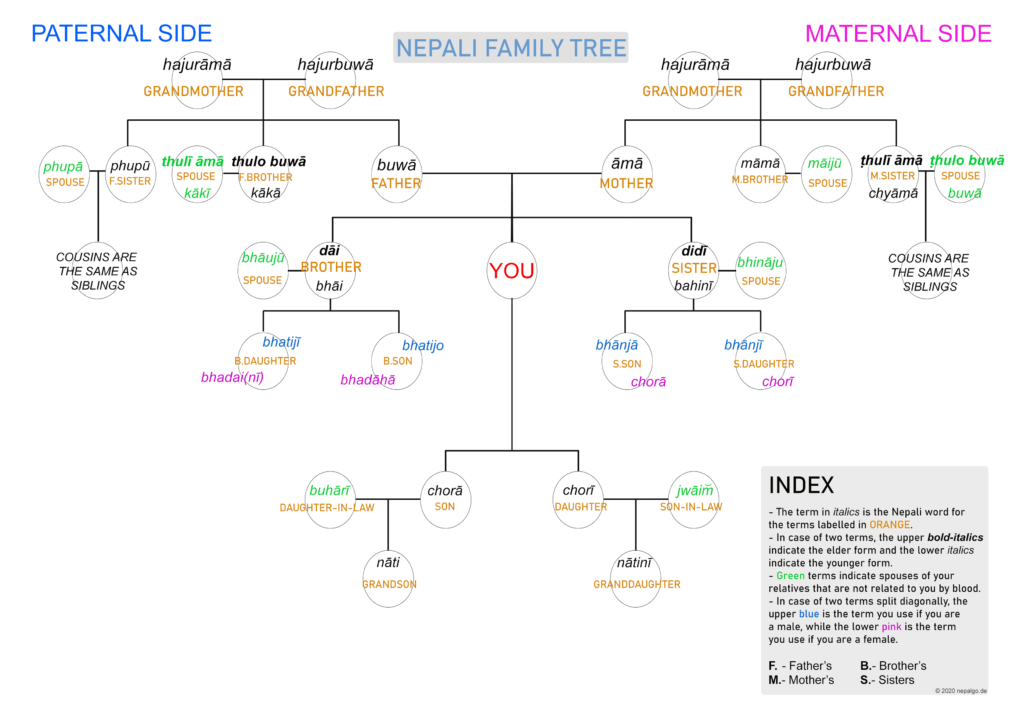
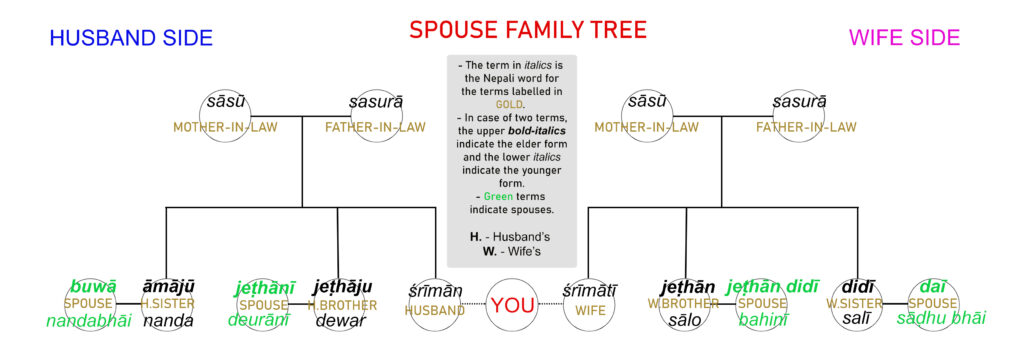
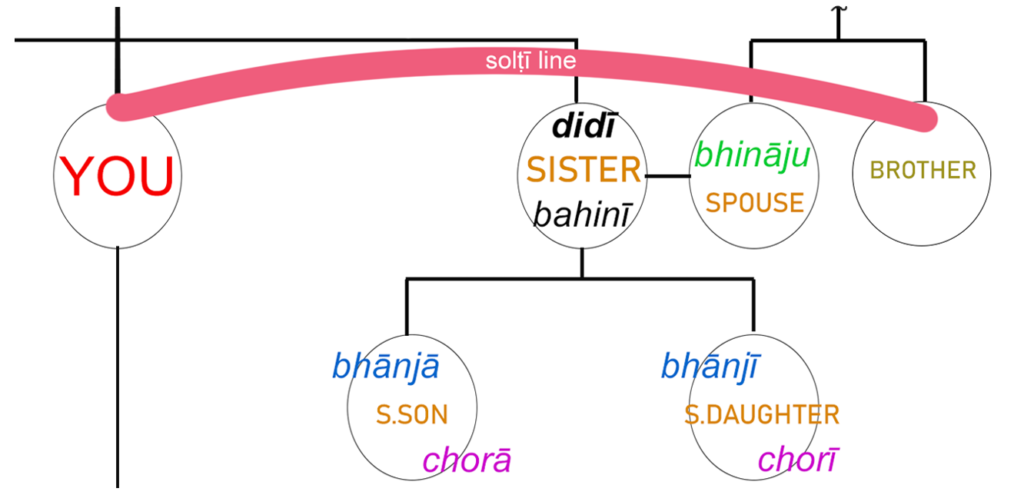
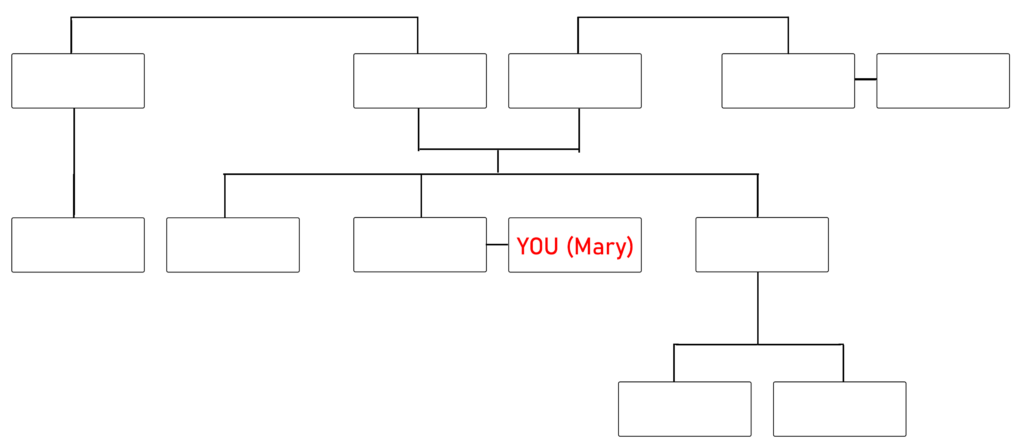
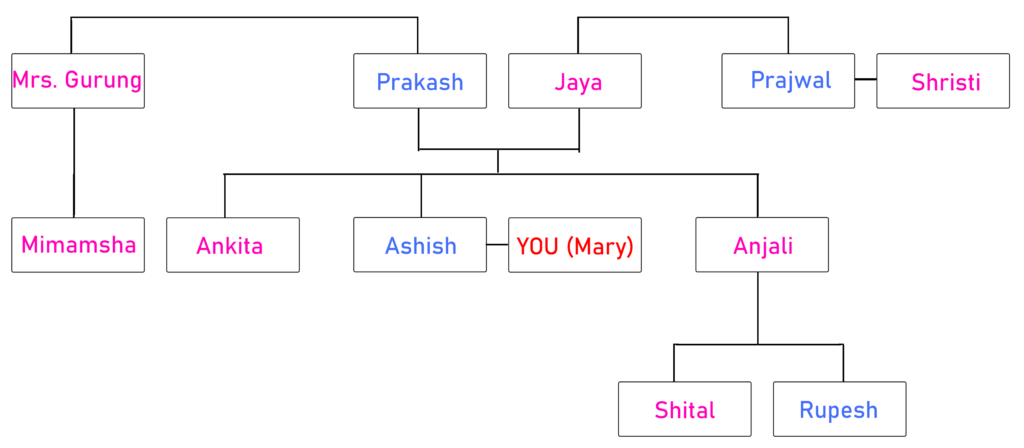
“ Totally Awesomeeeee “